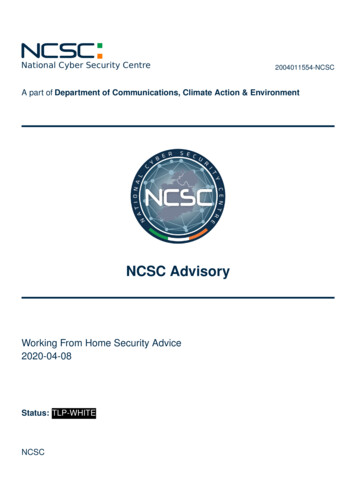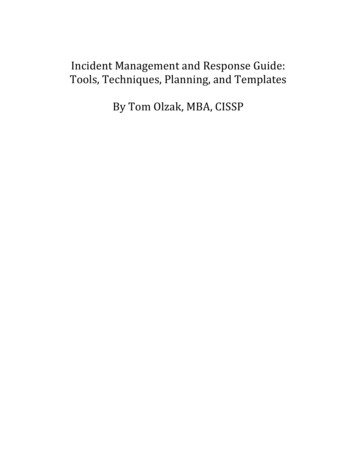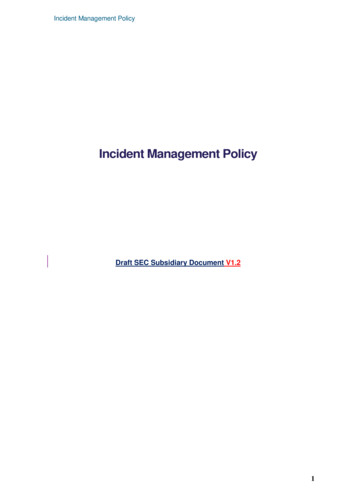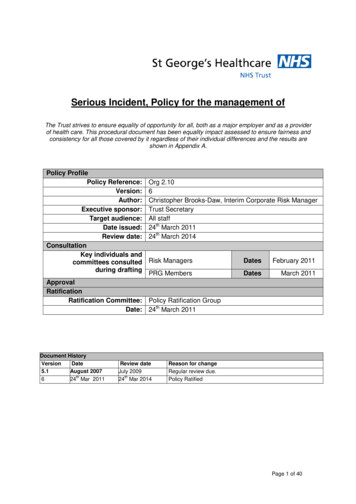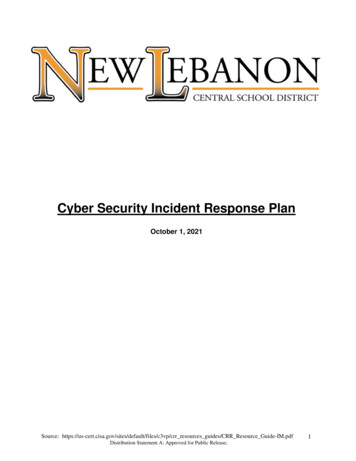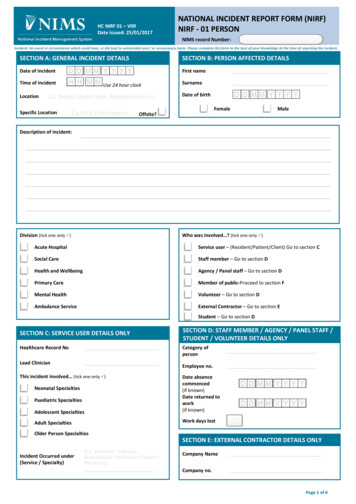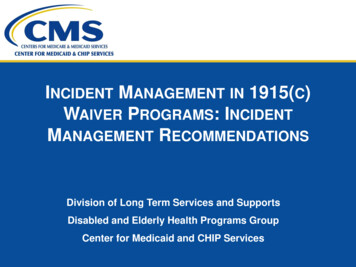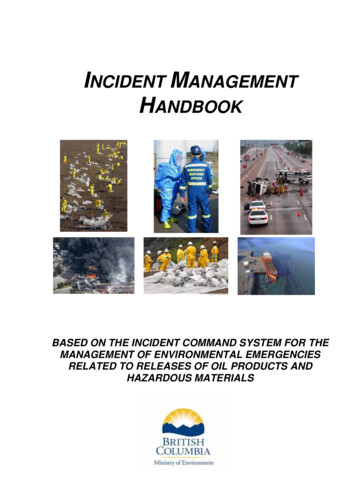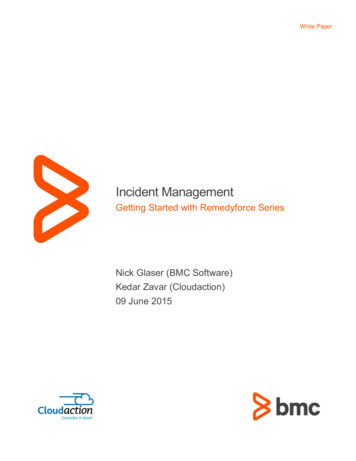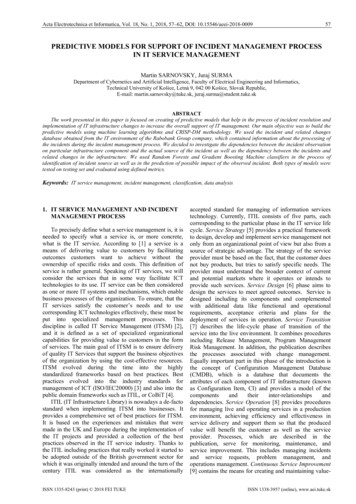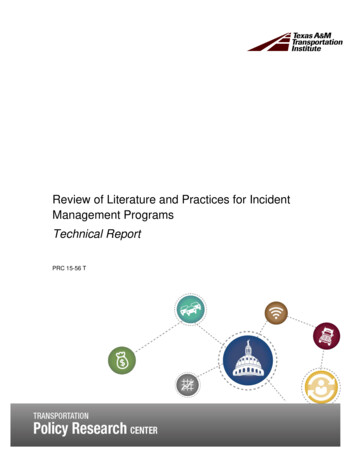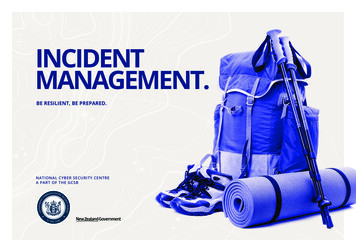
Transcription
INCIDENTMANAGEMENT.BE RESILIENT, BE PREPARED.NATIONAL CYBER SECURITY CENTREA PART OF THE GCSB
Incident Management: Be Resilient, Be Preparedsets out five key steps designed to help businessleaders and cyber security professionals strengthentheir organisation’s ability to manage and respond tocyber security incidents.This resource accompanies the NCSC’s guidance onenhancing organisational cyber security NT MANAGEMENT BE RESILIENT, BE PREPARED
Every year in New Zealand, hundredsof organisations are affected by cybersecurity events.The impact and severity of these eventsis determined by the complexity of eachincident, how rapidly it was detected, andthe ability of the affected organisation torespond.In a National Cyber Security Centre(NCSC) study2, New Zealand’s nationallysignificant organisations showed a needfor greater focus on readiness. The NCSChas identified the ability to respond toincidents as a key cyber security readinesschallenge for New Zealand e-report-released/ContentsWhat is Incident Management?4Incident Management: the First Five Steps8Step One: Define Roles and Responsibilities10Step Two: Identify Threats and Assets14Step Three: Have a Plan16Step Four: Logging, Alerting and Incident Automation18Step Five: Maintain Awareness, Report Progress, Continually Improve20The First Five Steps of Incident Management in Action22Scenario: Bellbird Optics23INCIDENT MANAGEMENT BE RESILIENT, BE PREPARED3
WHAT IS INCIDENTMANAGEMENT?Incident management is the overallpractice of managing cyber securityincidents. Incident managementinvolves the development,implementation and operation ofcapabilities that include people,processes and technology.Incident handling and incidentresponse are operational activities.These involve tactical practices todetect, respond to, and recover fromcyber incidents.4INCIDENT MANAGEMENT BE RESILIENT, BE PREPAREDInformation systems are critical assets for most organisations.Jeopardising the secure operation of these systems, and the businessprocesses they support, constitutes an unacceptable organisational risk.The risk of a cyber security incident cannot be managed withpreventative measures alone. A difficult but accepted reality in the cybersecurity profession is the unattainability of perfect prevention at anacceptable cost. Good frameworks recognise this and highlight detectionand response as being fundamental to achieving cyber resilience.
INCIDENTMANAGEMENT Define roles andresponsibilities Identify threatsand assets Create a plan Deploy logging,alerting and incidentautomation Maintain awareness,INCIDENTHANDLING Detect threats Manage logging,INCIDENTRESPONSEalerting and incidentExecuteautomationresponse plan. Maintain awareness,report progress.report progress andcontinually improve.STRATEGIC PLANNINGONGOING ACTIVITYIMMEDIATE ACTIONINCIDENT MANAGEMENT BE RESILIENT, BE PREPARED5
Is your organisation ready?Who is this guidance for?Time is an important factor in determining the impact of an incident. TheExecutives and business leaders can use this guidance to inform anlonger an incident lasts, the more likely it is to cause major disruptionassessment of their organisation’s incident management readiness.and inflict significant cost. The key to reducing the duration of an incidentThis document describes the key elements of incident management,is prompt detection and response. Readiness is fundamental to efficientthen demonstrates their application using a fictional scenario. Forand effective incident management.information security managers or those with some knowledge ofOne readiness indicator is the preparation of an incident response plan.With a documented plan in place, an organisation can react quickly andincident management already, this guidance will help to reaffirm yourunderstanding of the subject.decisively when an incident occurs. Every organisation should have anBy reviewing and applying this guidance, organisations will be able toincident response plan and test it at least yearly to ensure it’s understoodenhance their incident management capabilities, strengthen their cyberand fit for purpose.resilience, and enable: increased confidence when pursuing new business opportunitiesOnly one third of organisations surveyed by the NCSC possessed andtested an incident response plan in the previous year. 41% of organisationswere either ‘mildly confident’ or ‘not confident’ in their ability to detect acyber intrusion.reliant on digital tools or processes; effective management of cost, disruption, and other impacts whenan incident occurs, and: improved organisational robustness and an ability to respond tochallenges.6INCIDENT MANAGEMENT BE RESILIENT, BE PREPARED
Conversation Starters are highlightedthroughout this document. These are designedto enable senior leaders to start usefulconversations with specialists or responsiblemanagers. Executives and boards may notplay hands-on roles in most incidents, but it’sstill their responsibility to understand incidentmanagement and ensure the capability is in place.INCIDENT MANAGEMENT BE RESILIENT, BE PREPARED7
INCIDENTMANAGEMENT:THE FIRST FIVESTEPS8INCIDENT MANAGEMENT BE RESILIENT, BE PREPAREDThe first five steps are fundamental toestablishing an incident management capability.They are the initial areas for an organisation tofocus on when commencing this process. Takingthese first steps will enable a foundational abilityto identify, respond and recover from cybersecurity incidents.Incident management capabilities and maturitylevels vary widely between organisations. Twoorganisations of similar sizes may have differingapproaches that reflect their risk appetites,business objectives and cultures. There is nosimple one-size-fits-all process for incidentmanagement; each case is unique and requirescontinuous refinement.
STEP ONESTEP FOURDefine Roles and ResponsibilitiesLogging, Alerting and IncidentAutomationDuring an incident, an organisation must know whoneeds to be involved, what their responsibilities are,and at what point in the process they should assist. Staffmembers should understand which actions they areauthorised to perform and when to escalate an issue.STEP TWOIdentify Threats and AssetsEvery organisation must understand its assetsand the potential threats these face. Assets—the services and information your business relieson—will be more vulnerable to some threats thanothers. Defining threat scenarios and doing so in aconsistent way is fundamental to cyber resilience.Identifying threats and assets gives scope to yourincident management programme.Rapid detection and response relies on having theright data. An architecture and capability to managelogs, events, alerts, and incidents should be defined.Identifying sources of data and determining theirvalue ahead of an incident will expedite the processesof detection, containment, and remediation.STEP FIVEMaintain Awareness, Report Progressand Continually ImproveAll organisations should maintain an ongoingprogramme of work to develop and improve incidentmanagement. Through a committed and continualprocess, even organisations with limited resourcescan steadily improve their capacities.STEP THREEHave a PlanAt the core of effective incident management is awell-established and tested plan. This plan describesthe actions required when something does go wrong,and details the resources needed to resolve theincident. Creating a plan should be the primary focusfor improving incident management.INCIDENT MANAGEMENT BE RESILIENT, BE PREPARED9
STEP ONE:DEFINE ROLES &RESPONSIBILITIESOrganisations may not have the resources to dedicate individuals orteams to specific incident management roles. In New Zealand, staffmembers often have many different tasks to perform. However, rolesand responsibilities should still be defined, even if they are additionalto other duties. If an organisation relies on outsourced IT services, clarifyand make explicit any assumed role and responsibility performed by athird party. The most effective way to do this is by capturing them in aRASCI chart. The process of defining a RASCI (Responsible, Accountable,The speed and effectiveness of an initialincident response will be increased byclearly establishing who should performwhich tasks, and when.Supporting, Consulted, and Informed) is explained in the NCSC’s CyberIncidents often arrive out of the blueand develop quickly, so it’s necessaryfor those involved to have animmediate awareness of the situationand be authorised to quickly performthe correct actions. It’s crucial to havea guide in place describing who canmake key decisions on behalf of theorganisation, and when issues needto be escalated. When will the leadership team be informed if a cyber incidentSecurity Governance Guidance1. Key roles you should considerare listed in this section.CONVERSATION STARTERS:has occurred? What are the thresholds for notifying different stakeholders? Who is involved in our organisation’s cyber incident response? Who will lead the coordination and response? What authority does the incident manager require to effectivelyrespond to incidents?110INCIDENT MANAGEMENT BE RESILIENT, BE -your-course-cyber-security-governance
Key IncidentManagement RolesTechnical SpecialistsIt is important that technical specialists for the different businessareas are designated, since they may be vital in helping to identify andcommunicate what has occurred during an incident. This includes rolesPrimary Contactsuch as infrastructure engineers, network specialists and softwaredevelopers.The initial contact for any suspected security incident, whether it’sreported from outside the organisation, by a staff member, or by adedicated detection capability. This point of contact needs to be clearlyBusiness Services Ownersdefined and communicated within the organisation. Typically an emailThe owners of business services delivered by the organisation should becontact for this role is also published on the website and a phoneidentified. If an incident occurs the service owners will often be requirednumber is communicated to all staff. Ideally there should also be anto make decisions about changes to the availability or configuration ofafter-hours contact method.their services, and they will have the best understanding of potentialbusiness impacts.Incident ManagerThe escalation process is covered in the incident response plan butCommunications Leadthere needs to be a clear understanding of who manages an incident.Even small organisations should nominate a person who can manageThe incident manager coordinates response and recovery activities. In acommunications. External communications tasks should be limited tosmaller organisation this role might be shared between several people,the authorised staff. In a major incident this responsibility may includeor there might be a roster system to designate who is responsible after-communications with customers and the media. Ensuring that this pointhours. The incident manager doesn’t necessarily have to be a cyberof contact has been identified and has knowledge of media handling issecurity expert; they need to be able to coordinate the response andvery important.ensure there’s a single person with a complete situational view. Forongoing incidents, this role may be passed from one person to anotherto provide staff with breaks and a chance to rest.INCIDENT MANAGEMENT BE RESILIENT, BE PREPARED11
Third Parties and Service ProvidersInsurance ProviderMany organisations utilise service providers (including cloud serviceIt is increasingly common for organisations to include some level ofproviders) or outsourcing partners. These may well be central to thecyber security cover in their insurance policies. Understanding whenmanagement and response of any incidents, depending on the scope ofand how to engage the insurance provider is critical because there aretheir services and support. It is vital to understand how to contact them,often conditions and requirements on invoking insurance claims. Somewhat their obligations are, and what response time is expected. The rightinsurance policies list pre-approved vendors you must use for incidentsupport contracts should be in place to receive the assistance required.response. This engagement strategy can have a significant impacton how an organisation responds to an incident, and what they canPrivacyThe issue of privacy is increasingly being scrutinised, and many Newcommunicate about the incident. It is often important to decide early onin an incident whether an insurance claim will be made or not, as thisdecides whether an insurance provider will need to be involved.Zealand organisations have a nominated or dedicated privacy lead. Ifan incident involves personally identifiable information it is importantthat a member of staff manages the privacy implications. This includesCrisis Managementensuring relevant legislation is adhered to (for example, the PrivacySome organisations have crisis management teams, especially if theyAct), the correct authorities are informed, and impacted individuals aredeal with human safety or are involved with national or local responseappropriately notified.services. In these cases, if an incident escalates it may be necessaryto engage the crisis management teams to coordinate activities. If theLegal CounselSmaller organisations may not employ an in-house legal counsel butthey usually have an agreement with an external agency. In any case,there must be a representative to assist with any legal queries as partof incident response. These tasks may include evidence gathering ordisclosure requirements, through to management of third parties toassist with incident response. In many organisations the legal team willalso advise on interactions with suppliers, such as insurance providers.12INCIDENT MANAGEMENT BE RESILIENT, BE PREPAREDcontacts and methods of engagement have been defined beforehand itwill make this process significantly easier in the event of a major incident.
Escalation ContactsThere should be clarity around escalation contacts if any of thedesignated response team members are not contactable. Incidentsmay occur after hours, or an incident could impact remote working orcalling capabilities that make it impossible for the primary contacts toprovide the right support. In these situations it must be clear who hasthe authority to act on behalf of the primary contacts and step into theappropriate roles.External SupportIf an incident escalates to a level where the organisation lacksthe capability to manage it appropriately, it is important to havedefined the escalation points for external support. This may be agovernment organisation such as the National Cyber Security Centre(NCSC) or the Computer Emergency Response Team (CERT NZ) butcould also include non-government specialist incident response teams.Notably, if forensic analysis is required, specialist teams should beengaged as soon as possible.“The New Zealand InformationSecurity Manual (NZISM) states:Agencies MUST detail informationsecurity incident responsibilitiesand procedures for each system inthe relevant Information SecurityDocuments. (7.3.5.C.01).”INCIDENT MANAGEMENT BE RESILIENT, BE PREPARED13
STEP TWO:IDENTIFYTHREATS ANDASSETSUnderstanding the threats to anorganisation’s assets and servicesis fundamental to effective incidentmanagement. When these are known,it’s possible to plan and prioritise themost likely threat scenarios. Withoutthis knowledge, an organisation’splan may be too broad and containinsufficient detail to be actionable.Workshops are an effective way to determine what is important to theorganisation and what might go wrong. Attendance at workshops shouldinclude those who understand the wider business, such as the leadershipteam and service owners, not just IT or security teams.Focus first on understanding what is most important to the organisationand identifying its key assets and services, from the perspective of eachparticipant. These assets need to be matched against a list of commonthreats to define the threat scenarios for which the organisation willprepare.Unlike the process of identifying assets, defining common threats mayrequire some preparation and research but there is no need to aim forperfection at first; rigour and structure can be built over time.CONVERSATION STARTERS: What are the assets and services most critical to the ongoing operationof the business? What is the business impact of a disruption or compromise of theseassets or services? How does our understanding of the assets and threats relate to ourbusiness continuity and disaster recovery planning? What are the biggest cyber security threats to the organisation andhow is the organisation prepared to protect, detect and respond tothese threats? Are the threats detailed in scenarios and prioritised in order of impactto the organisation?14INCIDENT MANAGEMENT BE RESILIENT, BE PREPARED
Identify Your AssetsKnow Your ThreatsStart by understanding what business information or services a systemA vast amount of information is available on current cyber securityholds, communicates or facilitates. A common way to capture this is in athreats. The difficulty is understanding which threats are the mostservice relationship model. After this is established, work out the relativeimportant and how they would impact the organisation. A smallpriority of systems and identify who in the business is responsible fororganisation could rapidly exhaust its limited budget by attempting tothem. Finally, each asset’s physical and logical location needs to beprotect itself against all potential threats.determined, including any cloud services or hosted environments.To address this challenge, consider the threats most relevant to theThese steps are necessary for good incident management becauseorganisation’s assets. Significant threats could be established throughthey enable:workshops, but keep in mind a scale of likelihood and focus on those understanding of potential business impacts during an incident; prioritisation of response activities based on business need; a better awareness of dependencies between business servicesand information assets; a more detailed awareness of the sensitivity and availabilitysimple threats requiring a minimum number of steps necessary to beeffective. These threats should be detailed in scenarios that describe thesteps that are likely to occur for these to impact the organisation and itsassets. Threat identification should be an ongoing activity to keep up withchanges in technology and the organisation.requirements of data associated with certain assets; the definition of criticality levels to direct prioritisation duringa response; identification of dependencies between assets, such as networkconnectivity, third parties, and cloud service providers.The PSR’s INFOSEC1 states: Identify the information and ICT systems that yourorganisation manages. Assess the security risks (threats and vulnerabilities)and the business impact of any security breaches.“If a supplier was thesource of an incident,what impact would thishave on any response?”INCIDENT MANAGEMENT BE RESILIENT, BE PREPARED15
STEP THREE:HAVE A PLANAt the core of effective incidentmanagement is a well-establishedplan for maintaining readiness andcoordinating a response. This includesdetermining what resources will berequired to achieve these tasks. Yourplan should be the focus for building onyour incident management readiness.Key Elements of IncidentManagement PlanningThe list of items in this section is not exhaustive but provides importantconsiderations for establishing and maintaining a response capability.RunbooksThese set out a pre-planned series of actions that are initiated when anincident occurs. The runbook draws on information gathered from thefive steps set out in this document. A runbook is constructed accordingto likely threat scenarios and important assets. The runbook’s actionsare triggered by an alert that has been classified based on pre-existinginstructions. All actions are performed by those assigned roles.Technical InstructionsA runbook may be executed by someone who doesn’t necessarily have abackground or experience in all the relevant technologies. It is thereforevital to maintain up-to-date technical instructions for the technologies, andto ensure that appropriate access to systems is available when required.16INCIDENT MANAGEMENT BE RESILIENT, BE PREPARED
ChecklistsEquipment and StorageChecklists are an important part of incident management. Writing aSome types of incident may require that information or evidence ischecklist of actions to complete when an incident occurs helps to focusstored until it can be recovered and analysed by external specialists. Ityour efforts during a stressful situation. This ensures the right evidence isis important that appropriately secured storage facilities are available.gathered, the appropriate staff are notified, and actions are clearly recorded.Response teams may require laptops or specialist devices to carry outtesting. This equipment should be readily available and configured priorEscalation Rulesto an incident occurring.Clear escalation rules should guide the runbooks and incident responseRegular Checksplans. These rules can be aligned to the threat level framework coveredin Step 5 and should have precise triggers for when potential incidentsEffective incident management is not just about responding to incidentsneed to be escalated. In some situations, imposing time limits for eachas they occur, it should also involve regular and documented checks.step may also help to prevent teams spending too long trying to restoreThese should include controls and systems checks, access reviews, alertsa system and delaying the escalation process.monitoring, and logs analysis. Proactive analysis will often reveal incidentsthat have gone unnoticed or systems that have stopped logging.Notification PlanIn support of the runbooks, there should be a notification plan containingCONVERSATION STARTERS:the contact details of all the relevant staff. This plan can include details What types of incidents are we prepared for?such as an on-call roster and a call tree to notify the right staff, including Who is available after hours if something goes wrong?who to call after hours. Is someone carrying out regular checks to ensure no notifications areCommunications Bridge If our systems are unavailable, do we still have a way to communicateMany incidents are managed using online communications technologies. Who can we call on if the situation becomes unmanageable?missed?It is important that these are defined and documented beforehand andand coordinate?are readily available for staff to connect to. It is vital to always have abackup communications system that runs outside of the organisation’sIT infrastructure. This can be used as a fall-back should the primary ITsystem be unavailable or potentially compromised.INCIDENT MANAGEMENT BE RESILIENT, BE PREPARED17
STEP FOUR:LOGGING,ALERTING ANDINCIDENTAUTOMATIONIt is important to draw a distinctionbetween events, alerts and incidents.Incidents compel action because asuspected breach of policy has occurred.Events and alerts are potential indicatorsof some anomaly being detected, andthese should be tuned to ensure thatfalse positives are minimised whilegenuine incidents are reported.18INCIDENT MANAGEMENT BE RESILIENT, BE PREPAREDEffective incident management requires the capability to manage logs,events, alerts and incidents in a systematic manner. Events and alertsmay be indicative of required actions, while logs provide data for reactiveanalysis. Many organisations are challenged by a large quantity of alertsbeing generated, and face the risk that some are unattended. Thissituation is being exacerbated by the rapid move to cloud services andthe use of multiple security technologies, each with distinct methods oflogging and analysing events.CONVERSATION STARTERS: How would our organisation detect an incident? Are we responding to all the alerts we are receiving? Are we receiving too many alerts because we aren’t tuning themcorrectly? If something happened, would we be able to go back and find theinformation in our logs? How far back can we go? Is it one week, one month, one year, or mightwe need longer? Have we produced reports for our security incidents?
LoggingFalse PositivesEstablish which systems produce log data. Once identified, determineAlerts can often prove to be indicators of routine activity that is notif that logging needs to be captured and stored. This data could bemalicious. A challenge is that too many false positives will quicklyused for investigative purposes, or it may be a longer-term complianceoverload even the largest security team and result in genuine incidentsrequirement. Define the most cost-effective method of storing this data:being missed. It is vital to establish a process that ensures false positivesthis could be on-site or in a cloud environment.are rapidly tuned out and to focus on the alerts that indicate a likelyOne of the most common problems to occur during a major incident isthat insufficient logging data is available. Some investigations will needto go back months, and if detailed logs are not available the investigationmay need to rely on guesswork and draw assumptions which could beincorrect and not identify the root cause of the incident.incident. False positives should still be logged as they may be relevant tofuture investigations.Incident Response AutomationThe events and alerts that trigger an incident should be clearly definedand managed. They should be aligned to threats as defined in Step 2Events and Alertsand actioned in a timely fashion in accordance with the incident plan.Understand which systems are producing events and alerts, and whereand pushed to the relevant support teams with clear runbooks to followthese are being directed. Tune all the events and alerts to ensure theyare producing information relevant to the organisation and the definedIdeally, incident responses should be automated as much as possibleand action.threat scenarios. Capture these and, ideally, forward them into adedicated tool or service management system.“If data doesn’t needto be retained, don’tstore it unnecessarily.”INCIDENT MANAGEMENT BE RESILIENT, BE PREPARED19
STEP FIVE:MAINTAINAWARENESS,REPORT PROGRESS,CONTINUALLYIMPROVEEffective incident management is acontinuous practice and there is alwaysscope for improvement.20INCIDENT MANAGEMENT BE RESILIENT, BE PREPAREDA part of building cyber maturity is maintaining an active awareness ofthe current threat landscape. The organisation should ensure its securitycapabilities continually evolve to meet new threats. By considering thesefactors it is possible to ensure that ongoing investment is focussed onthe right areas.CONVERSATION STARTERS: What is our current threat level? Do we need to change our threat level in response to a vulnerabilityannouncement? Have we tested our ability to restore from backups recently? Do we have methods of responding to specific threats? Are we improving our incident management capabilities? Have we produced reports for our security incidents?
Key Considerationsfor Step FiveThreat-Level FrameworkA threat-level framework is composed of clearly defined levels ofresponse and readiness within an organisation. The threat level isbased on exposure to current threats, both internal and external,and could reflect unusual network behaviour, a new vulnerability, oreven a restructure within the organisation. On a day-to-day basis anThese factors will be vital when an incident does occur. By havingpractised, staff will be more confident and better able to manage apotentially stressful situation.Testing could be as simple as running a workshop with key stakeholdersand working through threat scenarios or simulating an outage. It couldeven involve contracting a third party to test threat scenarios. It’simportant that testing and validation is aligned with the threats identifiedin Step 2, and that they leverage runbooks that are part of the incidentmanagement plan described in Step 3.organisation may be at a guarded state, but if there is a targeted phishingMetrics and Reportingcampaign or an active incident the threat level will be elevated.It is crucial that the effectiveness of the incident management capabilityEach successive threat level should include clearly defined triggers, authorityto move between levels, notifications, and pre-approved response actions.The actions will vary depending on the threat but could include blockingcertain types of traffic or disconnecting systems and isolating them from thenetwork. Establishing a framework like this is an iterative process but shouldbe continually refined and updated based on lessons learned.Testing and ValidationA plan is only as good as the last time it was tested. Building outresponse plans aligned to threats is useful but these need to be tried outin practice. Testing establishes whether: the defined roles and responsibilities are appropriate for the staffassigned to them;is reported and measured against clear metrics. One way to beginthis process is to create a dashboard. The measurable or quantifiablecomponents of a dashboard should centre on events, alerts andincidents, and management of false positives. Eventually it will bepossible to report on the mean time to detect incidents and the meantime to restore systems as key metrics.Near-Miss AnalysisOne particularly useful way of improving incident management is to carryout near-miss analyses. Like health and safety reviews, these ana
incident management programme. STEP THREE Have a Plan At the core of effective incident management is a well-established and tested plan. This plan describes the actions required when something does go wrong, and details the resources needed to resolve the incident. Creating a plan should be the primary focus for improving incident management.
